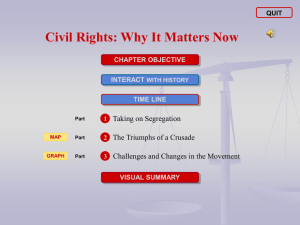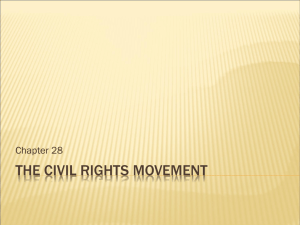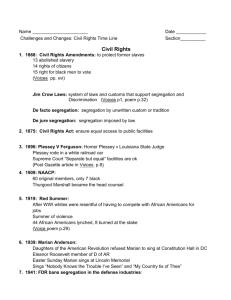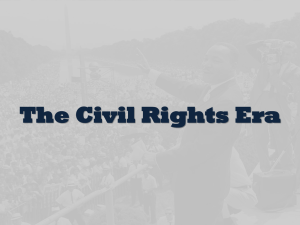Pre-test.doc - Dblockhonorsus2
advertisement
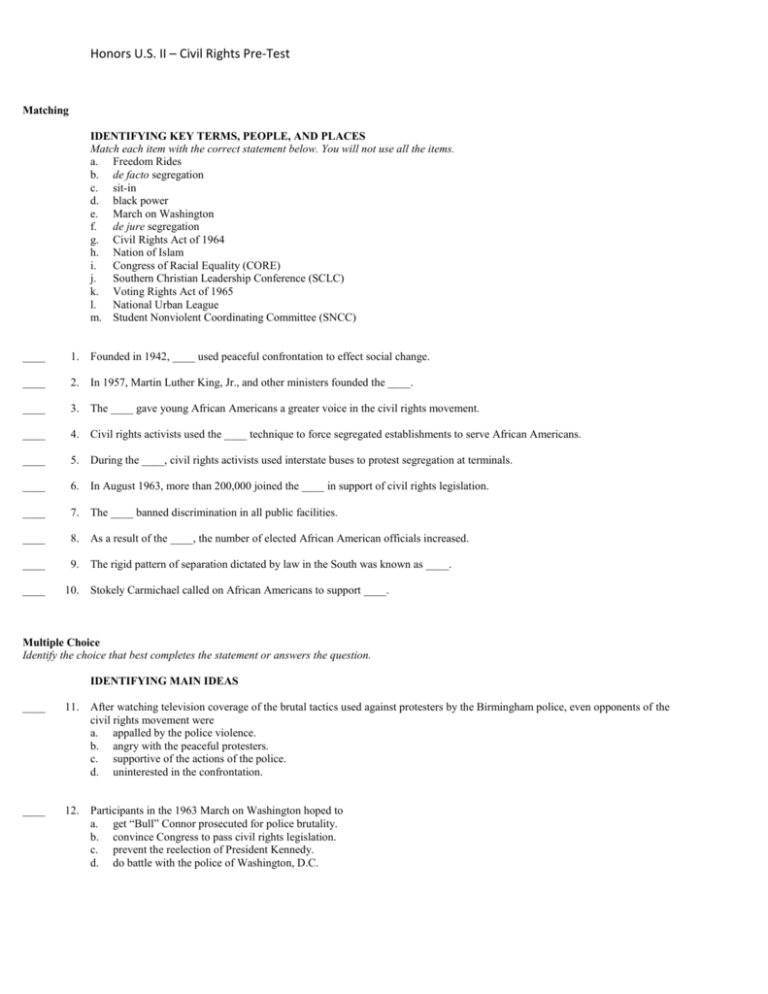
Honors U.S. II – Civil Rights Pre-Test Matching IDENTIFYING KEY TERMS, PEOPLE, AND PLACES Match each item with the correct statement below. You will not use all the items. a. Freedom Rides b. de facto segregation c. sit-in d. black power e. March on Washington f. de jure segregation g. Civil Rights Act of 1964 h. Nation of Islam i. Congress of Racial Equality (CORE) j. Southern Christian Leadership Conference (SCLC) k. Voting Rights Act of 1965 l. National Urban League m. Student Nonviolent Coordinating Committee (SNCC) ____ 1. Founded in 1942, ____ used peaceful confrontation to effect social change. ____ 2. In 1957, Martin Luther King, Jr., and other ministers founded the ____. ____ 3. The ____ gave young African Americans a greater voice in the civil rights movement. ____ 4. Civil rights activists used the ____ technique to force segregated establishments to serve African Americans. ____ 5. During the ____, civil rights activists used interstate buses to protest segregation at terminals. ____ 6. In August 1963, more than 200,000 joined the ____ in support of civil rights legislation. ____ 7. The ____ banned discrimination in all public facilities. ____ 8. As a result of the ____, the number of elected African American officials increased. ____ 9. The rigid pattern of separation dictated by law in the South was known as ____. ____ 10. Stokely Carmichael called on African Americans to support ____. Multiple Choice Identify the choice that best completes the statement or answers the question. IDENTIFYING MAIN IDEAS ____ 11. After watching television coverage of the brutal tactics used against protesters by the Birmingham police, even opponents of the civil rights movement were a. appalled by the police violence. b. angry with the peaceful protesters. c. supportive of the actions of the police. d. uninterested in the confrontation. ____ 12. Participants in the 1963 March on Washington hoped to a. get “Bull” Connor prosecuted for police brutality. b. convince Congress to pass civil rights legislation. c. prevent the reelection of President Kennedy. d. do battle with the police of Washington, D.C. Honors U.S. II – Civil Rights Pre-Test ____ 13. After Congress passed the Voting Rights Act of 1965, a. the civil rights movement slowly ended. b. white Southerners still prevented most African Americans from voting. c. many African Americans were elected to office at all levels. d. the Supreme Court declared the law unconstitutional. ____ 14. The black power movement taught that African Americans should a. separate from white society and lead their own communities. b. strive to end segregation. c. emigrate to Africa. d. use nonviolent protest to bring about change. ____ 15. In which state did Freedom Riders encounter violent resistance? a. Michigan b. California c. Alabama d. West Virginia ____ 16. What did Malcolm X encourage African Americans to do? a. to fight for greater integration with white society b. to separate themselves from white society c. to love and pray for white people d. to abandon violent, militant tactics in favor of civil disobedience ____ 17. After the war, the African American civil rights movement a. lost its main leaders. b. focused on suing the military. c. accelerated. d. made few gains until the 1960s. ____ 18. President Truman ordered an end to discrimination in a. Arkansas. b. the armed forces. c. labor unions. d. the transportation industry. ____ 19. The Supreme Court decision in Brown v. Board of Education ended a. the “separate but equal” doctrine. b. Jackie Robinson’s career in baseball. c. Eisenhower’s support of civil rights. d. discrimination in the hiring of federal employees. ____ 20. The Montgomery bus boycott introduced a new generation of African American a. bus drivers. b. high school students. c. leaders. d. baseball players. ____ 21. The SCLC shifted the focus of the civil rights movement from a. the South to the North. b. church leaders to college students. c. political to economic goals. d. the North to the South. Honors U.S. II – Civil Rights Pre-Test ____ 22. Martin Luther King, Jr., influenced by Gandhi, believed in a. “an eye for an eye.” b. violent revolution. c. nonviolent protest. d. fighting back only if struck first. ____ 23. SNCC entrusted decisions about priorities and tactics to a. its white members. b. young activists. c. the SCLC. d. older, more experienced leaders. ____ 24. James Meredith advanced the cause of civil rights when he a. tried to enroll at Ole Miss. b. opened an integrated lunch counter. c. organized the Freedom Rides. d. became an air force officer. ____ 25. The person who wrote the famous “Letter from Birmingham Jail” was a. Eugene “Bull” Connor. b. James Meredith. c. Martin Luther King, Jr. d. John Lewis. ____ 26. The brutality against African Americans in Birmingham prompted Kennedy to a. vote for a fair housing bill. b. propose a strong civil rights bill. c. jail several southern Democratic leaders. d. release Martin Luther King, Jr., on bail. ____ 27. Johnson’s two civil rights laws are considered to be a. landmarks in American history. b. unconstitutional. c. too weak to enforce. d. too radical for the 1960s. ____ 28. Under the leadership of Stokely Carmichael, SNCC became a. somewhat more religious. b. more open to white Americans. c. increasingly militant. d. less violent. ____ 29. Which of the following leaders were assassinated in 1968? a. Martin Luther King, Jr., and Robert Kennedy b. Robert Kennedy and Malcolm X c. Martin Luther King, Jr., and Malcolm X d. James Baldwin and Robert Kennedy ____ 30. All of the following resulted from the civil rights movement except a. making segregation illegal. b. opening the political process to more African Americans. c. eliminating poverty in the United States. d. giving African Americans a new sense of ethnic pride.

